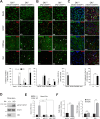Mature microRNA-binding protein QKI suppresses extracellular microRNA let-7b release
- PMID: 39308343
- PMCID: PMC11574364
- DOI: 10.1242/jcs.261575
Mature microRNA-binding protein QKI suppresses extracellular microRNA let-7b release
Abstract
Argonaute (AGO), a component of RNA-induced silencing complexes (RISCs), is a representative RNA-binding protein (RBP) known to bind with mature microRNAs (miRNAs) and is directly involved in post-transcriptional gene silencing. However, despite the biological significance of miRNAs, the roles of other miRNA-binding proteins (miRBPs) remain unclear in the regulation of miRNA loading, dissociation from RISCs and extracellular release. In this study, we performed protein arrays to profile miRBPs and identify 118 RBPs that directly bind to miRNAs. Among those proteins, the RBP quaking (QKI) inhibits extracellular release of the mature microRNA let-7b by controlling the loading of let-7b into extracellular vesicles via additional miRBPs such as AUF1 (also known as hnRNPD) and hnRNPK. The enhanced extracellular release of let-7b after QKI depletion activates Toll-like receptor 7 (TLR7) and promotes the production of proinflammatory cytokines in recipient cells, leading to brain inflammation in the mouse cortex. Thus, this study reveals the contribution of QKI to the inhibition of brain inflammation via regulation of extracellular let-7b release.
Keywords: AGO2; Extracellular vesicular miRNA; QKI; RNA-binding protein; let-7b.
© 2024. Published by The Company of Biologists Ltd.
Conflict of interest statement
Competing interests The authors declare no competing or financial interests.
Figures





References
-
- Arroyo, J. D., Chevillet, J. R., Kroh, E. M., Ruf, I. K., Pritchard, C. C., Gibson, D. F., Mitchell, P. S., Bennett, C. F., Pogosova-Agadjanyan, E. L., Stirewalt, D. L.et al. (2011). Argonaute2 complexes carry a population of circulating microRNAs independent of vesicles in human plasma. Proc. Natl. Acad. Sci. USA 108, 5003-5008. 10.1073/pnas.1019055108 - DOI - PMC - PubMed
-
- Asangani, I. A., Rasheed, S. A. K., Nikolova, D. A., Leupold, J. H., Colburn, N. H., Post, S. and Allgayer, H. (2008). MicroRNA-21 (miR-21) post-transcriptionally downregulates tumor suppressor Pdcd4 and stimulates invasion, intravasation and metastasis in colorectal cancer. Oncogene 27, 2128-2136. 10.1038/sj.onc.1210856 - DOI - PubMed
MeSH terms
Substances
Grants and funding
- P50 DC000422/DC/NIDCD NIH HHS/United States
- K99 CA207729/CA/NCI NIH HHS/United States
- R01 CA172567/CA/NCI NIH HHS/United States
- Brockman Foundation
- RP120348/Cancer Prevention and Research Institute of Texas
- R01 NS123456/NS/NINDS NIH HHS/United States
- P30 GM103342/GM/NIGMS NIH HHS/United States
- R37 NS067525/NS/NINDS NIH HHS/United States
- NRF-2022R1A2C4001528/National Research Foundation of Korea
- CA207729/CA/NCI NIH HHS/United States
- Medical University of South Carolina
- P50 DA000266/DA/NIDA NIH HHS/United States
- Medical College of Georgia, Augusta University
- University of Oklahoma
- R37 CA214800/CA/NCI NIH HHS/United States
- R01NS123456/NH/NIH HHS/United States
- R56 DC012058/DC/NIDCD NIH HHS/United States
- R01AA027532/NH/NIH HHS/United States
- 5R37CA214800/NH/NIH HHS/United States
- R01 GM126421/GM/NIGMS NIH HHS/United States
- R00 CA207729/CA/NCI NIH HHS/United States
- R01 DK120510/DK/NIDDK NIH HHS/United States
- R01 NS067525/NS/NINDS NIH HHS/United States
- R01NS123456/NS/NINDS NIH HHS/United States
- P20 GM103542/GM/NIGMS NIH HHS/United States
- R01 DC012058/DC/NIDCD NIH HHS/United States
- R01 AA027532/AA/NIAAA NIH HHS/United States
LinkOut - more resources
Full Text Sources
Miscellaneous

